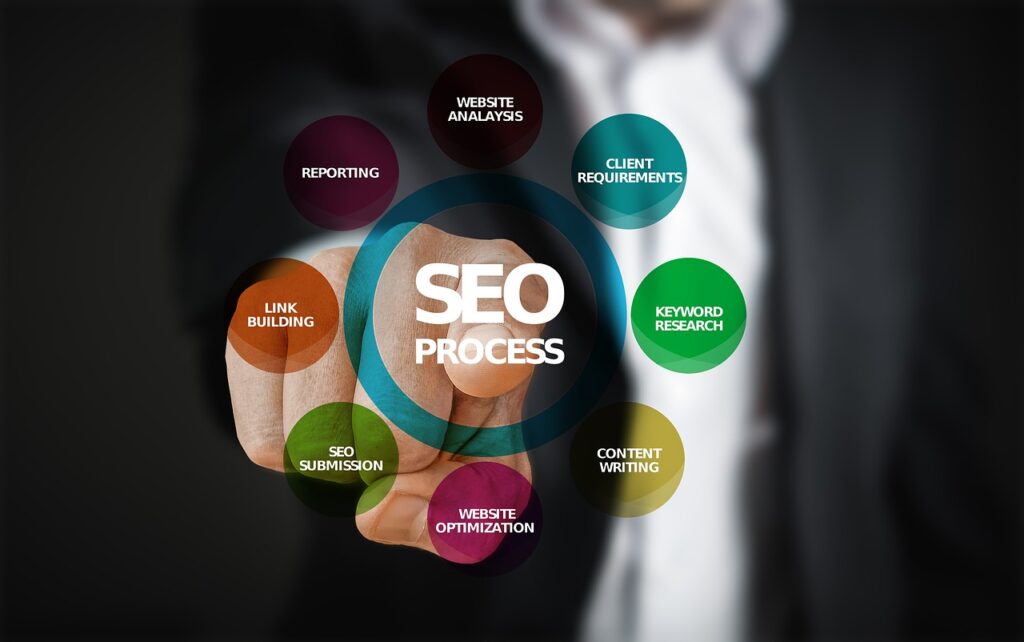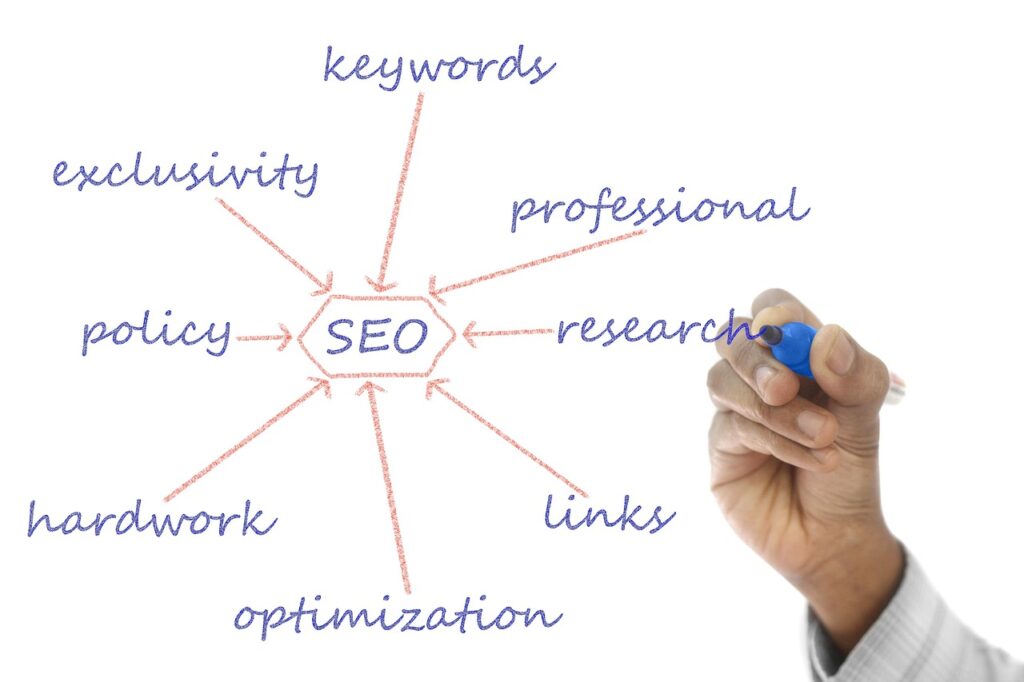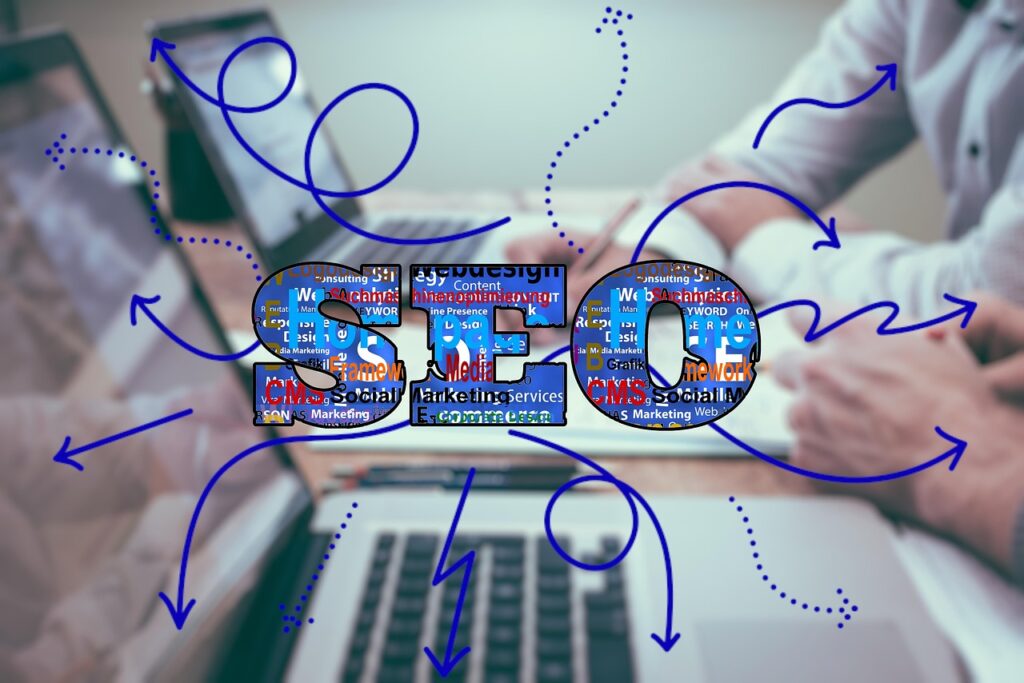SEO and website optimization services to increase ranking and speed
Website SEO refers to a set of actions such as link-building strategies, image optimization, professional cache settings, and the use of a CDN. Through website optimization, improvements in search engine performance, enhanced user experience, increased traffic, and organic visits are achieved. If you choose Rosaly Web’s SEO services, you will also have access to site speed enhancement, technical SEO, content optimization, and conversion rate optimization (CRO).

Familiarity with different SEO methods for website optimization
SEO is one of the main tools for business growth, as it essentially means improving a website to increase its visibility in search engines. This strategy includes four types, all of which work together to achieve comprehensive website optimization.
On-Page SEO:
- This type of SEO primarily targets the internal structure of websites and optimizes it to prepare the site for competition in online arenas.
- Title Tag Optimization
- Meta Description Optimization
- Keyword Integration in Content
- Header Tag Optimization (H1, H2, H3)
- Image Optimization (Alt Text, File Size)
Off-Page SEO :
- Off-Page SEO focuses on increasing domain authority through various techniques.
- Link Building
- Content Marketing
- Social Media Marketing
- Influencer Marketing
- Branding & Brand Signals.
Technical SEO
Local SEO
Local businesses enter their information into Google My Business to enhance their site and attract more traffic. They also use region-related keywords, regularly report site performance, and apply necessary optimizations.
Why is the website SEO process essential?
The SEO process (Search Engine Optimization) ensures the success of any website because it brings numerous benefits to sites. SEO is like building a physical store on a busy main street. Without SEO, your website remains hidden and unnoticed despite having great products or services. We will share more reasons why SEO is important.
First reason: Get better ranking
SEO, using specialized strategies and techniques, helps your website achieve a higher ranking in search engine results like Google. By improving ranking and creating high-quality links, the likelihood that users will see your site more and click on relevant links increases.
Second reason: Increase organic traffic
Achieving higher rankings in search results through site optimization leads to increased free (organic) and targeted traffic to the website. This traffic consists of users and visitors actively searching for the products, services, or information you provide.
Third reason: Credibility & Trust
Websites that appear high in search results after being evaluated and ranked by Google’s complex algorithms are generally more credible and trustworthy than those ranked lower. Users also tend to click on and trust top results more.
Fourth reason: Improved User Experience
SEO is not only about search engines but also helps improve the overall user experience on your website. This includes increasing site speed, easy navigation, fast page loading, high-quality content, and mobile compatibility—all of which are desirable for users.
Fifth reason: Return on Investment (ROI)
Compared to paid advertising methods (such as pay-per-click ads), SEO offers a longer-term and more sustainable return on investment. By providing a high-quality, engaging, and relevant site that meets users’ needs, organic traffic tends to be more sustainable and doesn’t require continuous payment for each click.
Sixth reason: Better user understanding
By analyzing SEO data, you gain a better understanding of your audience’s behavior, needs, and search terms. This information is very valuable for creating more relevant content and more effective marketing strategies.
Seventh reason: Gaining a competitive advantage
If your competitors are performing SEO processes like WordPress caching, using CDN, etc., and you ignore them, you will fall behind in search results. SEO helps you stand out in the competitive online market.
Eighth reason: Gaining measurability
SEO allows you to track and measure your efforts by analyzing website traffic, keyword rankings, and other metrics. This valuable capability cannot be achieved with any other technique.
Ninth reason: Staying up-to-date
SEO helps you stay up-to-date with the latest trends and best practices in the online world. It also ensures that your website is optimized for search engines and users according to the most current methods.
Techniques to increase website speed
By applying SEO methods and page load standards, increasing website speed and reducing bounce rate are achievable benefits. However, to reach these goals, various techniques are needed for this purpose.

Image optimization:
Image optimization is not only about using appropriately sized images but also paying attention to the format and type of the image significantly improves optimization. Using JPEG format for natural images and PNG for detailed images increases loading speed. Also, compressing images before uploading with tools like TinyPNG or Photoshop is a notable technique. Ask ChatGPT
Lazy Load
In this method, images are not loaded in the background until the user opens a page on the site. Then, as the user scrolls to the area with images or videos, they are loaded and displayed one by one with continuous scrolling, thereby reducing the bounce rate.
Caching
Storing pages in the visitor’s browser cache and enabling WordPress caching—including page caching, browser caching, and server caching for temporarily storing site data in a folder on the host—is an effective approach to improve website speed. Some of the most important WordPress caching plugins include:
WP Super Cache
W3 Total Cache
LiteSpeed Cache
Cache Enabler
Comet Cache
بهینه و فشردهسازی کدها:
Minifying CSS and JavaScript files in the website’s source code, while maintaining structure and readability, aims to reduce file size and significantly speeds up page loading from the server, thus increasing website speed. Combining CSS and JavaScript files to reduce the number of requests, removing unnecessary code, and using optimization plugins like Autoptimize are also beneficial in this regard.

Reducing the number of HTTP requests
Combining CSS and JavaScript files, using in-line images for small visuals, and removing or disabling unnecessary plugins and scripts prevent the browser from requesting many separate files from the server to display a web page. This increases page load speed and improves user experience.
Using a Content Delivery Network (CDN)
Using a Content Delivery Network (CDN) helps distribute your website’s content across multiple servers worldwide, storing your website files on various servers globally. This way, when a user from a specific region accesses the site, the files are delivered from the nearest CDN server to increase loading speed and improve website performance.
Choosing the hosting
Using a hosting service with high speed and quality, reliable with sufficient resources to support the number of visitors (unlimited bandwidth) is important. Additionally, choosing a flexible hosting with good security, optionally equipped with a separate database server, and a strong, updated control panel is essential to achieve maximum speed.
Database optimization
Database optimization techniques reduce query response time, adjust database parameters (allocated memory and number of connections), and increase overall database speed. These techniques include removing redundant data, using indexes, table partitioning, shortening transactions, and using optimization plugins to enhance speed and improve site ranking on Google.
Using speed testing tools
Using dedicated tools to test website speed and receive optimization suggestions should be part of the workflow. Here is a list of some of the most important tools:
PageSpeed Insights
Gtmetrix
Google PageSpeed Insights
WebPageTest
Pingdom Website Speed Test
Dareboost

Using CDN and Caching
Using a Content Delivery Network (CDN) and caching technology improves website performance and increases loading speed. CDN, as a network of servers, first checks cached content and delivers it to the user; if the content is not in the cache, it retrieves it from the main server and serves it.
Of course, caching reduces access time to repeated data by temporarily storing it. Accordingly, the benefits of CDN include increased loading speed, reduced load on the main server, improved user experience, enhanced resistance to DDoS attacks, and reduced bandwidth costs. The benefits of caching include temporary data storage, reduced access time, reduced server load, and improved website performance and optimization.
But with the combination of these two technologies, special benefits await online users:
Fast website loading and immediate readiness for use
Main server load distribution and bandwidth consumption reduction
Reducing costs related to website maintenance
Increasing website stability
Enhancing resistance against attacks
Improving website SEO
Providing scalability (managing high traffic, popular content)
Improving user experience and gaining more user satisfaction
And so on.
Image optimization for SEO:
Image optimization for SEO leads to better image rankings in search engine results, enhanced user experience, increased site traffic, and reduced hosting and bandwidth costs. Accordingly, image improvement is as valuable and important as content improvement. Key aspects of this process include creating unique and original images, compressing without quality loss, and using descriptive alternative text (alt text).
Of course, by adding relevant names, improving image loading speed, using responsive images (desktop, mobile, and tablet), and updating images, you can optimize your site’s images for search engines and benefit from it. Below, we list other methods for image and SEO optimization in the form of a checklist.
Choosing the appropriate format (JPEG, PNG, WebP, GIF)
No copying or duplication (copyright)
Paying attention to image file structure (creating subfolders with related topics and categorization)
Properly creating page title and description (part of image search algorithm)
Specifying image dimensions in source code
Adding images to the sitemap
Creating a backlink strategy using high-quality and unique images
Creating a good URL structure for images
Using schema markup
Using a Content Delivery Network (CDN)
Removing EXIF metadata before uploading images
Browser caching activation

Improving site ranking on Google through SEO reporting continuous improvement
In reporting for improving site ranking on Google, site performance is regularly reviewed using SEO tools and based on available data, continuous site optimization is performed. This process includes identifying high-traffic pages, site strengths and weaknesses, keyword analysis, link review, content evaluation, and user experience assessment. This ensures the site achieves a better ranking in Google search results.
Stages of site ranking improvement through reporting and continuous optimization:
Regular review and analysis of site performance with analytical tools like Google Search Console and Google Analytics
Identifying high-traffic and relevant keywords using tools like Google Keyword Planner
Optimizing content using title tags, meta descriptions, etc.
Checking the accuracy and validity of internal and external links
Improving user experience (UX)
Using responsive design for proper site display
Simplifying site navigation for users

Final words:
SEO services focusing on technical and content optimization improve your ranking in search engines and enhance user experience by increasing site speed. The ultimate goal of this process is to increase real visitors and achieve business objectives. So, transform your online presence with SEO.


